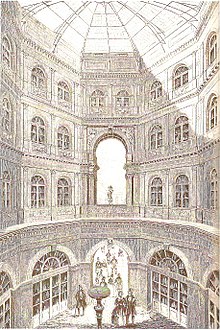Sillem's Bazaar
The Sillem's Bazar in Hamburg was the first large shopping mall in Germany in 1843 .
history
In 1842 large parts of Hamburg were destroyed by the great fire . This also applied to the area between Jungfernstieg and Königstrasse (today Poststrasse ), where the Hotel Alte Stadt London had stood. The Hamburg businessman Wilhelm Sillem had the Hamburg architect Eduard Averdieck build the Hôtel de Russie , whose predecessor on Jungfernstieg was also destroyed, and the Sillem's Bazar for high demands on this vacant spot . The designation with an apostrophe corresponded to the spelling customary at the time. Hotel and passage were based on the model of European metropolises . Together they formed a structural unit; the target group were well-funded strollers and luxury lovers . The passage could also be entered through the entrance of the hotel. The magnificent building consisted of two glass-covered side corridors in which around 30 shops provided a wide range of goods. Mirror panes, gilding and marble walls created a noble ambience .
The center of the passage was the showpiece and consisted of an elegant glass octagon, i.e. a large octagonal square , which the passage immediately enclosed. The suites of the hotel were on the upper floors . The roof was made entirely of glass and thus - similar to many shopping malls today - ensured brightness and a flood of light. With that, the idea of strolling and shopping regardless of the weather was also implemented in a German metropolis. The modern iron and glass construction with its illusionistic effects attracted the attention and admiration of the Hanseatic people and visitors. “Going to Hamburg and not seeing the bazaar is like Rome without the Pope” read the press and the Leipziger Illustrirte reported: “In the passage the sense of size is combined with that of splendor and elegance, with the tendency to metropolitan dazzling and great. It surpasses its role models, those elegant passages in Paris and London that are just as pleasant and useful in bad weather in general beauty and tasteful execution of all individual parts. ” The entrance fee for visiting the passage was five shillings .
Despite the attractive building, a disadvantage of the location soon became noticeable: the passage connected two unequal streets, namely on the one hand the splendid Jungfernstieg boulevard , which was already one of the most popular promenades at the time, and on the other hand a less busy alley. As a result, strollers and shoppers had no real destination when walking. The bazaar was not a real connection between two equally busy nodes. This meant that customers stayed away to the extent necessary to run expensive businesses. In 1881 - 38 years after the passage was built - it was demolished.
The luxury hotel Hamburger Hof opened on December 16, 1882 on the site of Sillem's Bazar . The imposing building was the work of the renowned architects Bernhard Georg Hanssen and Emil Meerwein and was later converted into an office building. Today the building again contains a shopping arcade with a passage from Jungfernstieg to Poststrasse and the Hanse district.
literature
- Ernst Christian Schütt u. a .: Chronicle of Hamburg. 2nd updated edition. Bertelsmann Lexikon Verlag, Gütersloh / Munich 1997, ISBN 3-577-14443-2 .
- Hamburg's new buildings: V. Der Bazar , in Illustrierte Zeitung , no. 105, July 5, 1848, Leipzig, pages 12-14, digitized
- Passage (bazaar) of Mr. W. Sillem. In: Hamburg address book , alphabetical directory of local public institutions, charitable foundations and associations, scientific institutes, buildings worth seeing and other peculiarities, initially for foreigners, 1848, pp. 455–456, digitized



